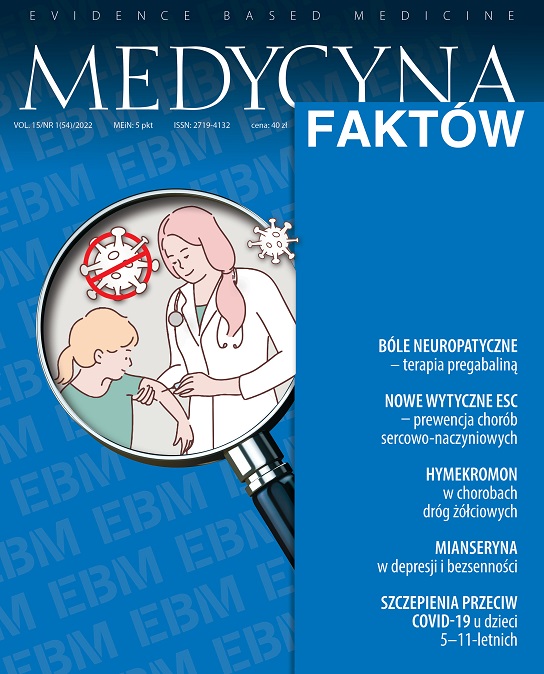Hymekromon w terapii chorób dróg żółciowych oraz nowe perspektywy terapeutyczne leku ? przegląd literatury Artykuł przeglądowy
##plugins.themes.bootstrap3.article.main##
Abstrakt
Hymekromon (4-metyloumbeliferon; 7-hydroksy-4-metylokumaryna) to dobrze znany lek o udokumentowanej skuteczności w chorobach dróg żółciowych mający bardzo korzystny profil bezpieczeństwa, co sprawia, że jest chętnie stosowany przez lekarzy i pacjentów. Lek ten ma unikalny trójfazowy mechanizm działania, który obejmuje: działanie choleretyczne ? wzmaga wydzielanie żółci o niskiej gęstości; działanie cholekinetyczne ? stymuluje przepływ i wydalanie żółci do jelit ? oraz działanie spazmolityczne ? zmniejsza napięcie mięśni gładkich dróg żółciowych, a także zwieracza Oddiego. W ostatnich latach pojawiły się doniesienia o nowych właściwościach hymekromonu, które budzą duże zainteresowanie w kontekście jego potencjalnego zastosowania w innych niż obecnie zalecane wskazaniach, w tym w chorobach nowotworowych, zapalnych i autoimmunologicznych. W artykule omawiamy klasyczny i nowy mechanizm działania hymekromonu ze szczególnym uwzględnieniem jego roli w dyskinezach dróg żółciowych.
##plugins.themes.bootstrap3.article.details##
Copyright ? by Medical Education. All rights reserved.
Bibliografia
2. Sobol E, Muszyński J. Biliary dyskinesia. Przewodnik Lekarza/Guide for GPs. 2005; 8(3): 98-106.
3. Hundt M, Basit H, John S. Physiology, Bile Secretion. 2021 Oct 1. In: StatPearls [Internet]. Treasure Island (FL): StatPearls Publishing; 2021.
4. Boyer JL. Bile formation and secretion. Compr Physiol. 2013; 3(3): 1035-78. http://doi.org/10.1002/cphy.c120027.
5. National Center for Biotechnology Information. PubChem Compound Summary for CID 5280567, Hymecromone (access: 11.01.2022).
6. CHARAKTERYSTYKA PRODUKTU LECZNICZEGO. Cholestil Max (access: 16.01.2022).
7. Nagy N, Kuipers HF, Frymoyer AR et al. 4-methylumbelliferone treatment and hyaluronan inhibition as a therapeutic strategy in inflammation, autoimmunity, and cancer. Front Immunol. 2015; 6: 123. http://doi.org/10.3389/fimmu.2015.00123.
8. Abate A, Dimartino V, Spina P et al. Hymecromone in the treatment of motor disorders of the bile ducts: a multicenter, double-blind, placebo-controlled clinical study. Drugs Exp Clin Res. 2001; 27: 223-31.
9. Krawzak HW, Heistermann HP, Andrejewski K et al. Postprandial bile-duct kinetics under the influence of 4-methylumbelliferone (hymecromone). Int J Clin Pharmacol Ther. 1994; 33: 569-72.
10. Trabucchi E, Baratti C, Centemero A et al. Controlled study of the effects of tiropramide on biliary dyskinesia. Pharmatherapeutica. 1986; 4: 541-50.
11. NFZ. Polipragmazja, czyli wielolekowość w praktyce (access: 11.01.2022).
12. Richmond BK. Optimum utilization of cholecystokinin cholescintigraphy (CCK-HIDA) in clinical practice: an evidence-based review. W V Med J. 2012; 108(2): 8-11.
13. Richmond BK, Walker A. Biliary Dyskinesia: Current Perspectives and Future Directions. Am Surg. 2021; 87(6): 954-60. http://doi.org/10.1177/0003134820971617.
14. Ponsky TA, DeSagun R, Brody F. Surgical therapy for biliary dyskinesia: a meta-analysis and review of the literature. J Laparoendosc Adv Surg Tech A. 2005; 15: 439-42. http://doi.org/10.1089/lap.2005.15.439.
15. Rehman S, Singh KK, Sajid MS. Role of laparoscopic cholecystectomy in the management of chronic right upper quadrant pain due to biliary dyskinesia: a systematic review and meta-analysis. Transl Gastroenterol Hepatol. 2019; 4: 71. http://doi.org/10.21037/tgh.2019.08.10.
16. Richmond BK, Grodman C, Walker J et al. Pilot Randomized Controlled Trial of Laparoscopic Cholecystectomy vs Active Nonoperative Therapy for the Treatment of Biliary Dyskinesia. J Am Coll Surg. 2016; 222(6): 1156-63. http://doi.org/10.1016/j.jamcollsurg.2016.02.022.
17. Alhayo S, Eslick GD, Cox MR. Cholescintigraphy may have a role in selecting patients with biliary dyskinesia for cholecystectomy: a systematic review. ANZ J Surg. 2020; 90(9): 1647-52. http://doi.org/10.1111/ans.16003.
18. Cotton P, Morgan K, Bingener J et al. Cholecystectomy for Gallbladder Dyskinesia. J Am Coll Surg. 2016; 223: 204-5. http://doi.org/10.1016/j.jamcollsurg.2016.03.036.
19. Krishna YT, Griffin KL, Gates RL. Pediatric Biliary Dyskinesia: Evaluating Predictive Factors for Successful Treatment of Biliary Dyskinesia with Laparoscopic Cholecystectomy. Am Surg. 2018; 84(9): 1401-5.
20. Liebe HL, Phillips R, Handley M et al. A pediatric surgeon?s dilemma: does cholecystectomy improve symptoms of biliary dyskinesia? Pediatr Surg Int. 2021; 37(9): 1251-7. http://doi.org/10.1007/s00383-021-04922-1.
21. Lennard TW, Farndon JR, Taylor RM. Acalculous biliary pain: diagnosis and selection for cholecystectomy using the cholecystokinin test for pain reproduction. Br J Surg. 1984; 71: 368-70. http://doi.org/10.1002/bjs.1800710521.
22. Marinho A, Nunes C, Reis S. Hyaluronic Acid: A Key Ingredient in the Therapy of Inflammation. Biomolecules. 2021; 11(10): 1518. http://doi.org/10.3390/biom11101518.
23. Vitale DL, Icardi A, Rosales P et al. Targeting the Tumor Extracellular Matrix by the Natural Molecule 4-Methylumbelliferone: A Complementary and Alternative Cancer Therapeutic Strategy. Front Oncol. 2021; 11: 710061. http://doi.org/10.3389/fonc.2021.710061.
24. Karbownik MS, Nowak JZ. Hyaluronan: towards novel anti-cancer therapeutics. Pharmacol Rep. 2013; 65(5): 1056-74. http://doi.org/10.1016/s1734-1140(13)71465-8.
25. Piccioni F, Fiore E, Bayo J et al. 4-methylumbelliferone inhibits hepatocellular carcinoma growth by decreasing IL-6 production and angiogenesis. Glycobiology. 2015; 25(8): 825-35. http://doi.org/10.1093/glycob/cwv023.
26. Rodríguez MM, Onorato A, Cantero MJ et al. 4-methylumbelliferone-mediated polarization of M1 macrophages correlates with decreased hepatocellular carcinoma aggressiveness in mice. Sci Rep. 2021; 11(1): 6310. http://doi.org/10.1038/s41598-021-85491-0.
27. Nagy N, Kuipers HF, Marshall PL et al. Hyaluronan in immune dysregulation and autoimmune diseases. Matrix Biol. 2019; 78-9: 292-313. http://doi.org/10.1016/j.matbio.2018.03.022.
28. Yang YM, Wang Z, Matsuda M et al. Inhibition of hyaluronan synthesis by 4-methylumbelliferone ameliorates non-alcoholic steatohepatitis in choline-deficient L-amino acid-defined diet-induced murine model. Arch Pharm Res. 2021; 44(2): 230-40. http://doi.org/10.1007/s12272-021-01309-7.
29. Corpechot C, Gaouar F, El Naggar A et al. Baseline values and changes in liver stiffness measured by transient elastography are associated with severity of fibrosis and outcomes of patients with primary sclerosing cholangitis. Gastroenterology. 2014; 146(4): 970-9.
30. Vesterhus M, Hov JR, Holm A et al. Enhanced liver fibrosis score predicts transplant-free survival in primary sclerosing cholangitis. Hepatology. 2015; 62(1): 188-97.
31. Corpechot C, El Naggar A, Poujol-Robert A et al. Assessment of biliary fibrosis by transient elastography in patients with PBC and PSC. Hepatology. 2006; 43(5): 1118-24.
32. A Study of Oral Hymecromone and Hyaluronan Synthesis (access: 11.01.2022).
33. Mazzetti M, Marconi G, Mancinelli M et al. The Management of Cholestatic Liver Diseases: Current Therapies and Emerging New Possibilities. J Clin Med. 2021; 10(8): 1763. http://doi.org/10.3390/jcm10081763.
